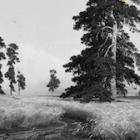Showers, Kate B. “Prehistory of Southern African Forestry: From Vegetable Garden to Tree Plantation.” Environment and History 16, no. 3 (August 2010): 295–322. doi:10.3197/096734010X519771. Republished by the Environment & Society Portal, Multimedia Library. http://www.environmentandsociety.org/node/7610.
Desiccationist discourses and fears dominated official concern in nineteenth and early twentieth century southern Africa grassland ecosystems. When scientific forestry arrived in Cape Town, government bureaucracies changed and Africa’s first forestry department was created. Yet there were few trees in southern African grassland ecosystems requiring a forest service. Tree planting was advocated. The introduction of alien trees and their spread from coast to interior preceded that of the concept of forestry. The earliest source of tree planting materials was Cape Town’s Dutch East India Company’s garden, established in 1652. Gardens as the primary source of trees and planting information was formalised in the nineteenth century with the rise of botanical gardens. Missionaries and settlers planted fruit and fuel trees for subsistence, and ornamentals for aesthetics while defining new frontiers. Despite officially sponsored tree planting competitions, it was private plantations of eucalyptus and acacia trees to supply the needs of mines, industry and the wattle bark export market, and not afforestation campaigns, that led to significant tree cover. Tree introductions did change southern African hydrologies, but not in the way imagined by anti-desiccationist campaigners: streams dried up and water tables dropped. Tree planting was regulated as a threat to South African water supplies in the late twentieth century, and plans were made to ‘deforest’ the landscape to enhance water storage.
— Text from The White Horse Press website
All rights reserved. © 2010 The White Horse Press


